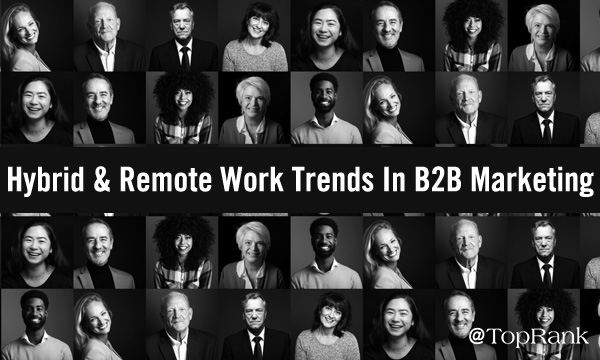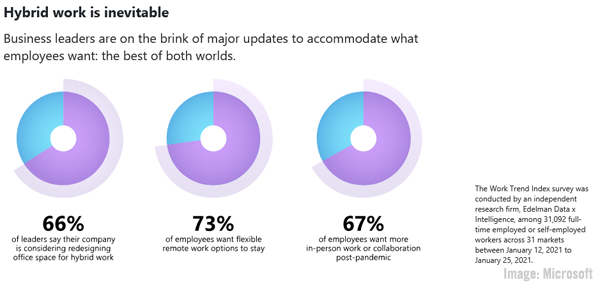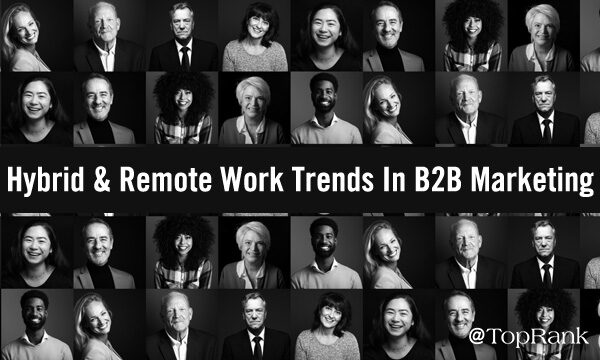
How is the shift to remote and hybrid work affecting B2B marketers?
Which trends will endure in the post-pandemic marketing landscape?
The dramatic shift to hybrid and remote work that has been brought about by the pandemic is set to forever alter the way B2B marketers and the organizations they work for and with do business.
Let’s take a look at some of these changes, and the trends that are likely to permanently affect B2B marketers, and I’ll offer my own perspective coming from a long-term background in remote work.
Flexibility: Remote & Hybrid Options May Come Permanent
On Monday, March 23, 2007 I started my life of working remotely — a process I wrote about last year as the pandemic first began forcing much of the workforce into unfamiliar remote work situations. In “Day 4,777: Remote Work Tips From 13+ Years As A Distance Marketer,” I looked at how B2B marketers can thrive in the new era of remote work, and offered a variety of tips I’ve picked up during my time as a remote worker.
Since then a great deal has changed in the world. I’m up to 5,106 days of working remotely, and what was once a tiny segment of the workforce has over the past year grown to encompass a massive swath of workers worldwide, including those working in the B2B marketing industry.
Leaders at organizations worldwide have shifted from what had been seen as a temporary emergency move to remote work, to implementing permanent and fundamental changes involving remote and hybrid work variations.
“It’s a very interesting time for the history of work, not even just the history of remote work. I think fundamentally work is going to change, and it’s never going back to the way it was before.” — Liam McIvor Martin @vtamethodman Share on XA Convergence of Forces is Driving Remote Worker Relocation Options
This hybrid and remote work sea change has also had far-reaching and sometimes unforeseen implications. Workers in major metropolitan centers have come to realize that they’re no longer necessarily required to be tethered to a particular work location, and not just within their city, as growing numbers of professionals are leaving cities such as San Francisco and New York for locations that are a world away — and not only in size and cost-of-living.
This week CNN’s John D. Sutter explored the phenomenon from a climate change perspective, in “As people flee climate change on the coasts, this Midwest city is trying to become a safe haven,” another factor that has coincided with the pandemic to fuel a new era of remote and hybrid work options.
The safe haven city Sutter’s piece focuses on is Duluth, Minnesota — which happens to be my home of the past 26 years. The city of 86,000, a few hours north of Minneapolis, is where I’ve worked remotely for some 14 years now. My wife Julie and I live next door to Duluth mayor Emily Larson, who shared with Sutter that, “We are known as the San Francisco of the North. I’ll let you decide if you think that’s true.”
Most who visit Duluth do indeed see more than physical similarities with San Francisco — the hills of Duluth line the vast waters of Lake Superior — and I have technology industry friends who have moved here from both San Francisco and New York, thanks to burgeoning remote work opportunities.
The convergence of the pandemic and ongoing climate change create a scenario where more B2B workers than ever now have opportunities to consider living wherever they wish, and as we learn more about the ramifications of widespread remote and hybrid work, many are seeing more positive elements to the shift than negative ones.
B2B marketers and the organizations they work for and with will increasingly need to address these urgent hybrid and remote work changes, whether it’s in attracting and keeping talent, how we communicate with one another, or in the very stories brands are telling in their marketing efforts.
The Ensuing Hybrid Work Disruption
A recent study by one of the world’s biggest employers, Microsoft, has tackled many of these issues, with the March release of “The Next Great Disruption Is Hybrid Work – Are We Ready?”
Some of the fascinating take-aways from the Microsoft report, gathered from data in 31 counties and more than 30,000 people, along with more than a trillion anonymous signals from its Microsoft 365 and LinkedIn* products, include the following:
- 40 percent of the workforce has considered leaving their employer over the past year
- 73 percent of workers want to continue having flexible remote work options
- 65 percent crave spending additional in-person time with their teams
- 66 percent of business decision makers are considering redesigned physical work-spaces to better suit hybrid work
- 46 percent have said their employer doesn’t provide help with remote work expenses
- 67 percent want more in-person work or collaboration after the pandemic
- Time spent in meetings has more than doubled
- Team chat messaging has increased by 45 percent
- 1 in 5 have met their colleagues’ pets or family members virtually over the past year
- 39 percent say they’re now more likely to be their full and authentic selves at work
- Remote job postings on LinkedIn have climbed by more than five times
- 46 percent of remote workers plan to move to a new location this year
On this last point, Karin Kimbrough, chief economist at LinkedIn, noted in the Microsoft report that, “This shift is likely to stick, and it’s good for democratizing access to opportunity,” Kimbrough said. “Companies in major cities can hire talent from underrepresented groups that may not have the means or desire to move to a big city. And in smaller cities, companies will now have access to talent that may have a different set of skills than they had before,” she added.

B2B Marketers Rethink Hybrid & Remote Work
The shift to hybrid, flexible, and remote work options is an active and ongoing process to be certain, however significant movement has already been made. The genie of rethinking work fundamentals has been set in motion, and can’t ever be put back in its bottle.
New studies highlighting shifting perspectives on remote and hybrid work are publishing frequently, such as a recent WeWork and Workplace Intelligence report which found that 64 percent of employees said they were willing to pay for access to office space to support hybrid work, and that 75 percent would forgo at least one job benefit or perk in order to have the freedom to choose their work environment.
A Gartner survey showed that some 80 percent of business leaders plan to allow remote work once the pandemic has ended.
How B2B marketers react to these changes is likely to be crucial to thriving among increased post-pandemic competition.
We hope that this brief glimpse into a few of the remote and hybrid work changes that are already taking place, and others likely to be implemented in the years to come, will help inform your own marketing efforts.
To dig even deeper into remote work issues, be sure to watch our Break Free B2B Marketing video interview episode featuring Liam McIvor Martin, co-founder of Time Doctor and Staff.com: Break Free B2B Marketing: Liam McIvor Martin of Time Doctor on The Revolutionary Power of Remote Work.
Contact us today to find out why brands from SAP, LinkedIn, and Adobe to IBM, Dell, Cherwell Software, monday.com and more have chosen TopRank Marketing, and also check out our careers page including remote and hybrid positions.
*LinkedIn is a TopRank Marketing client.



